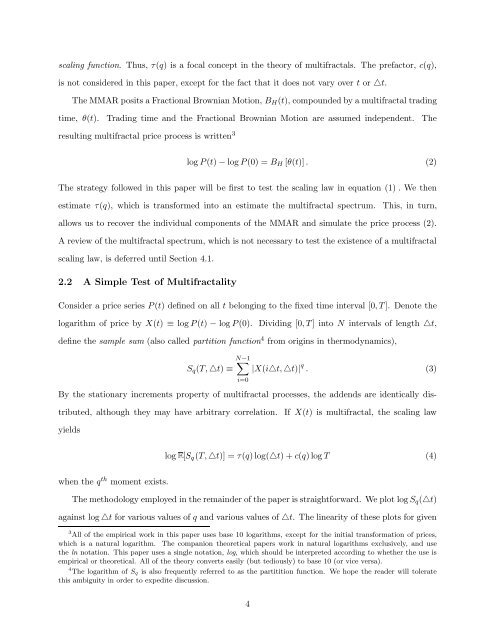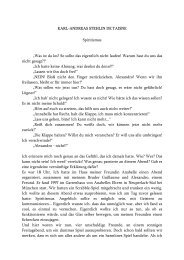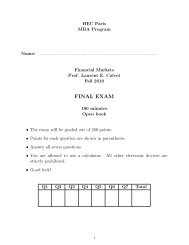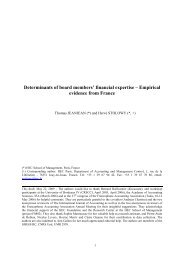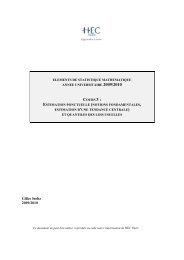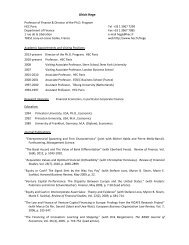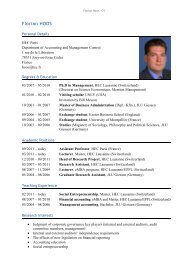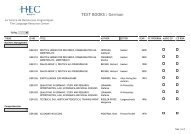Multifractality of US Dollar/Deutsche Mark Exchange Rates - Studies2
Multifractality of US Dollar/Deutsche Mark Exchange Rates - Studies2
Multifractality of US Dollar/Deutsche Mark Exchange Rates - Studies2
Create successful ePaper yourself
Turn your PDF publications into a flip-book with our unique Google optimized e-Paper software.
scaling function. Thus, τ(q) is a focal concept in the theory <strong>of</strong> multifractals. The prefactor, c(q),<br />
is not considered in this paper, except for the fact that it does not vary over t or △t.<br />
The MMAR posits a Fractional Brownian Motion, BH(t), compounded by a multifractal trading<br />
time, θ(t). Trading time and the Fractional Brownian Motion are assumed independent. The<br />
resulting multifractal price process is written 3<br />
log P (t) − log P (0) = BH [θ(t)] . (2)<br />
The strategy followed in this paper will be first to test the scaling law in equation (1) . We then<br />
estimate τ(q), which is transformed into an estimate the multifractal spectrum. This, in turn,<br />
allows us to recover the individual components <strong>of</strong> the MMAR and simulate the price process (2).<br />
A review <strong>of</strong> the multifractal spectrum, which is not necessary to test the existence <strong>of</strong> a multifractal<br />
scaling law, is deferred until Section 4.1.<br />
2.2 A Simple Test <strong>of</strong> <strong>Multifractality</strong><br />
Consider a price series P (t) definedonallt belonging to the fixed time interval [0,T]. Denote the<br />
logarithm <strong>of</strong> price by X(t) ≡ log P (t) − log P (0). Dividing [0,T]intoN intervals <strong>of</strong> length △t,<br />
define the sample sum (also called partition function 4 from origins in thermodynamics),<br />
Sq(T,△t) ≡<br />
N−1 <br />
i=0<br />
|X(i△t, △t)| q . (3)<br />
By the stationary increments property <strong>of</strong> multifractal processes, the addends are identically dis-<br />
tributed, although they may have arbitrary correlation. If X(t) is multifractal, the scaling law<br />
yields<br />
when the q th moment exists.<br />
log E[Sq (T,△t)] = τ(q)log(△t)+c(q)logT (4)<br />
The methodology employed in the remainder <strong>of</strong> the paper is straightforward. We plot log Sq(△t)<br />
against log △t for various values <strong>of</strong> q and various values <strong>of</strong> △t. The linearity <strong>of</strong> these plots for given<br />
3 All <strong>of</strong> the empirical work in this paper uses base 10 logarithms, except for the initial transformation <strong>of</strong> prices,<br />
which is a natural logarithm. The companion theoretical papers work in natural logarithms exclusively, and use<br />
the ln notation. This paper uses a single notation, log, which should be interpreted according to whether the use is<br />
empirical or theoretical. All <strong>of</strong> the theory converts easily (but tediously) to base 10 (or vice versa).<br />
4 The logarithm <strong>of</strong> Sq is also frequently referred to as the partitition function. We hope the reader will tolerate<br />
this ambiguity in order to expedite discussion.<br />
4


